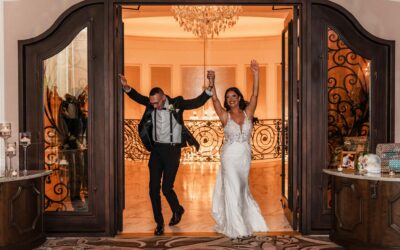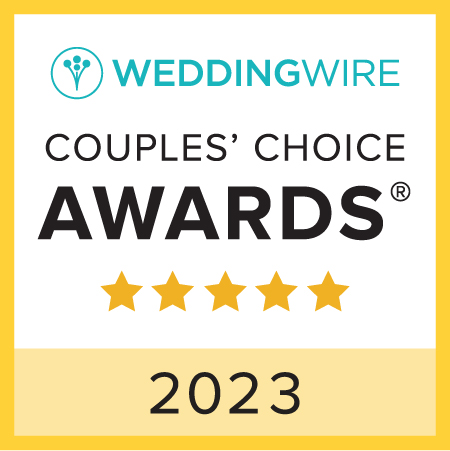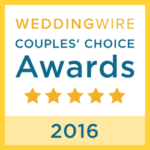A Glossary of Wedding Flowers by Season
By working largely with what’s “in season,” you’ll be getting the flowers when they’re at their absolute best.
Whether you and your soon-to-be spouse absolutely love flowers or are learning about them for the first time as part of the wedding-planning process, you’re likely hearing a great deal about seasonality. While most flower varieties can be sourced at any time of the year (with lots of pre-planning and for the right price, that is), working with what’s in-season means you’re getting the flowers when they’re absolute best. But “at their best” doesn’t mean for a lower price. According to florist Jessica De Corse, founder of Ellamah, “seasonal” and “cheap” have become synonymous in the world of wedding flowers, but it’s time to put that misconception to rest. “Seasonal flowers are not ‘cheaper,'” she says. “Seasonal flowers mean that you are getting those flowers at their best. When you get flowers that are out of season, they are of less quality (think small heads, weak stems, etc.) and are more expensive than if you got them during their actual season. So, seasonal flowers do not cost less; they offer a better value.”
Amanda Theodoropoulos, co-owner of Twisted Willow Flowers, largely echos that sentiment, but also adds that working with local, in-season flowers can result in a small savings. “When we purchase local flowers, we eliminate travel miles, which means there’s less cost to ship and less time from cut to the vase,” she explains. Lauren Anderson and Rachel Bridgwood, co-founders of Sweet Root Village, add that the value you gain from choosing flowers that aren’t shipped from faraway locales can’t be downplayed. “A flower being clipped from the farm into a bucket and traveling down the street to you delivered in water is going to last longer and look fresher than a bloom that is clipped at an earlier stage, cold packed, traveling all around the world, through customs, and wholesalers before being trucked all over the country in boxes,” they say.
Simply put, working with as many in-season flowers on your wedding day is the best way to ensure the quality and overall look of your floral décor is at its very best. If budget is your primary concern, Kristen Griffith-VanderYacht, owner of Wild Bloom, urges couples to share any budget concerns with their florist early on. “If you are looking to save money be sure to communicate that with your florists,” he says. “A good floral designer will be able to educate and help you make thoughtful design decisions within your budget.”
Curious what flowers will be at their best on the day you say “I do?” Here, we share a breakdown of flowers that are in-season during the spring, summer, fall, and winter, as well as expert-approved tips and budget details you need to know.
Spring
If flowers are your biggest wedding-day priority, spring might be the right wedding season for you. After all, spring is when some of the most stunning flowers—like peonies, lilacs, tulips, garden roses, and more—are most readily available. “Spring is the best!” says Griffith-VanderYacht. “You basically have your pick of the most amazing bulb flowers.”
Daffodil
As one of the first harbingers of spring, emerging as the ground begins to thaw at the end of each long winter, daffodils are practically must-haves for weddings taking place in late March or April. Available in yellow and white, these single-bloom stems give off straight sunny-weather vibes. And they can stand on their own or shine with other spring stunners like roses and ranunculus. Just keep daffodils in numbers since legend has it that a boutonniere with one single daffodil can bring bad luck.
Tulip
In addition to being absolutely beautiful, tulips signify “perfect love,” making them a wonderful fit as a wedding-day flower. Plus, their riotous colors—tulips are available in everything from pure white and blush pink to bright yellow, bold red, deep purple, and more—mean this bloom type is as versatile as they come. In recent years, florists have taken to using tulips in even more creative ways, opening their colorful petals wide to create lush, statement accents in arrangements.
Flowering Branches and Shrubs
“One of our favorite parts about spring are the blooming branches and foliage!” say Anderson and Bridgwood. “Give us all the spirea, quince, cherry blossom, and more!” If texture, height, and pops of color are important to you, work with your florist to prioritize adding cherry blossoms, forsythia, spirea (we’re especially fond of the bridal path variety for weddings), quince, mock orange, and dogwood. “There is something so magical about walking into a room full of pink cherry blossoms,” Griffith-VanderYacht adds. De Corse says mock orange, a flowering deciduous shrub with delicate white flowers, is her favorite option for springtime arrangements.
Sweet Pea
Dainty sweet peas add texture and movement to any wedding bouquet or centerpiece, which is why our experts love to use them when they’re in-season each spring. Available in shades of pink, blue, white, purple, and red, sweet peas are beautiful accent blooms; arranged en-masse, they also make a statement all on their own. Anderson and Bridgwood say you can generally expect to pay anywhere from $5 to $10 per stem for sweet pea.
Lilac
With a blink-and-you’ll-miss-it growing season, lilacs are one of spring’s most fleeting flowers; if your wedding date aligns with their peak season, utilize these fragrant blooms to their fullest. “Some [flower] varieties have a short window availability—I am talking about a week,” explains De Corse, and that’s certainly true of these blooms, which come in shades of pale and dark purple as well as white.
Lily of the Valley
If you loved Kate Middleton’s wedding bouquet (who didn’t?), then lily of the valley should be on your own big-day bloom radar. While her arrangement was also comprised of sweet William, ivy, myrtle, and hyacinth, a posey made up of just these delicate bell-shaped blooms would be extremely beautiful.
Peony
Fluffy, fragrant peonies have a relatively short growing season—while a single plant will have multiple buds, local varieties will only bloom once per year, right around the end of the season—so spring couples should absolutely take advantage of these glorious flowers. Of course, they are available out of season, but couples should expect a hefty price tag to have them on their wedding day; even in-season, these flowers can have a high price tag. “I’ve seen peonies go from $2.50 to almost $25 a stem in our markets (our cost) depending on the novelty of the variety,” says Theodoropoulos. Bridgwood and Anderson say $9 to $20 tends to be the average cost for a single peony.
Pieris Japonica
Also known as andromeda, pieris japonica is a shrub-like evergreen plant that flowers each spring, bursting into a colorful display of white or pale pink urn-shaped blooms. It’s a great textural option that works well as filler or to add body and depth to an asymmetrical arrangement.
Iris
Theodoropoulos cites irises as her favorite springtime bloom to work with, and it’s easy to see why: Available in a vast array of colors, including yellow, blue, white, pink, orange, brown, and purple, these versatile springtime flowers can play nicely with just about any color palette.
Summer
Long, warm days, glorious sunsets, balmy nights—what’s not to love about summer, especially in context of planning a wedding? If you’re tying the knot during late June, July, August, or early September, you’ll have a plethora of flowers to choose from, but it’s important to think about where they’ll be used—some flowers are more sensitive to intense heat, so anything that will be out of water (like your bouquet, boutonnière, or a ceremony backdrop) should contain mostly hardy blooms.
Garden Rose
By the time summer rolls around, garden roses—which are commonly mistaken for peonies—are bursting with color and fresh scent. Whatever you do, don’t be fooled by these flowers: It’s a common misconception that garden roses are the same as standard roses, but that’s absolutely not the case. Garden, or English, roses have more petals and a different overall shape. If you love the look a full, fluffy peony but aren’t a fan of the out of season price tag, a local garden rose could be a good stand-in. While Juliet garden roses have long been a wedding bouquet favorite, other varieties have become more and more popular in recent years; consider cappuccino, distant drum, or quicksand varieties for your arrangements.
Hydrangea
You’d be hard-pressed to name a flower more synonymous with the summer season than the hydrangea. Readily available in colors like white, blush, blue, purple, and green, these fluffy flowers take up a lot of space in arrangements, making them a solid option as a bouquet or centerpiece base. “Hydrangea is versatile and comes in many many colors,” says Griffith-VanderYacht. “For the ceremony, I love to use an abundance of Hydrangea to make a statement.” Just remember that these big flowers love water, so they aren’t always the best option for sun-soaked summer ceremonies. Anderson and Bridgwood say that hydrangeas generally cost between $8 and $12 a stem, but because they take up a significant amount of space in an arrangement, you can get away with using fewer flowers overall.
Clematis
The buttercup-shaped flowers that define this vining plant are endlessly versatile—have your florist let them dangle on the vine for a trailing, organic look or keep them arranged close to the base of a bouquet or centerpiece to add color and texture to a summery mix. Either way, you can’t go wrong. Available in pink, white, red, purple, blue, and even bi-color, clematis is a lovely accent in just about any arrangement.
Cosmo
Star-shaped and petite, there’s something wonderfully wispy about cosmos, which is why our experts love using them in summer arrangements. Reminiscent of a daisy, cosmos are known for their vibrant yellow centers and equally colorful petals—you can find them in white, pink, yellow, maroon, and orange.
Delphinium
There aren’t many naturally-occurring blue flowers, but delphinium (also known as larkspur) is one of them. If blue isn’t your thing, don’t count this tall flower out—it’s also available in pink, white, and sometimes even yellow. Arranged en-masse, delphinium makes for an amazing long-stemmed bouquet or statement aisle decoration.
Foxglove
If height and color are what you’re after, consider foxglove your floral soulmate. Tall stems comprised of many bell-shaped flowers, foxglove are available in bold shades like red, pink, yellow, white, and purple.
Scabiosa
De Corse loves working with scabiosa in the summer, when these pincushion-centered flowers are at their peak. And since they’re available in both classic (think: white, burgundy, and pink) and unexpected (think: black and deep purple) hues, scabiosa really pop when used in arrangements. In a bouquet, scabiosa lends a great deal of movement and texture to any arrangement, but your florist may need to stabilize the stem with wire so the flower doesn’t overwilt or break.
Sunflower
While they might not be a fit for every aesthetic, there’s something undeniably cheerful about the classic sunflower, which is at its peak during the warm-weather months. If you’re planning a casual or rustic wedding, these big-faced blooms will be right at home in your arrangements.
Zinnia
Symbolizing friendship, thoughtfulness, and endurance, zinnias are a great choice for wedding floral arrangements. You can find them in a wide range of colors, like pink, burgundy, yellow, orange, and even green.
Fruiting Branches
If you ask De Corse, there’s nothing like working with unexpected materials in the summer, and fruiting branches are her go-to. “Fruiting branches are quintessential summer to me,” she says. “I love working with fruiting branches, particularly blueberries in July.” Whether you add them to bouquets, boutonnières, or centerpieces, they’re guaranteed to pop.
Fall
Is there anything quite like a fall wedding? Mild temperatures, amazing foliage, epic sunsets, and a plethora of in-season flowers make this season an ideal time to say “I do.”
Dahlia
Though they begin to bloom in late summer, dahlias really come into their own during autumn, which is why Theodoropoulos refers to them as “everyone’s favorite fall flower.” What’s more, dahlias don’t always tolerate heat well, so they tend to fare better during the cooler months. “Autumn is typically packed with dahlias in all their incredible shapes and colors,” say Anderson and Bridgwood. Café au Lait dahlias, a variety of dinner plate dahlia available in a creamy-biege huge, has become a top choice for wedding arrangements in recent years, but our experts agree that any dahlia will be a knockout. You can find them in tons of colors, including burgundy, pink, yellow, and white, and they will generally cost between $3 and $5 per stem.
Japanese Anemone
Though they can start growing in late summer, Japanese anemone are at their best in the fall. Their season is fleeting, though, which is why De Corse says she loves working with this bloom “if she can catch it.” Their shape is a little different than a traditional anemone, but available in white, pink, and purple, these petite flowers are cheerful additions to any arrangement.
Foliage
If you see the word “foliage” and immediately think “filler,” you’re sorely mistaken—especially during the fall. De Corse says foliage is her favorite thing to work with during autumn, and for good reason: So many varieties of foliage are readily available and they provide tons of colors and movement to arrangements. “This season’s stars are foliage and texture, such as nandina, amaranthus, bittersweet vine, celosia, maple vine, and different grasses,” she says. “Working with nature’s second-spring transitional color branches will do the trick.” Anderson and Bridgwood add, “All kinds of grasses and millets tend to find their way into fall designs as well as the seasons crops start to dry out!”
Chrysanthemum
Chrysanthemums (or mums) have gotten a bad reputation as grocery store flowers, but florist-quality varieties are worth considering for your big day. And since they’re affordable, asking your florist to work chrysanthemums—which come in tons of colors like yellow, rust, burgundy, white, and orange—into your arrangements can help you bulk up the scale without breaking the bank.
Hanging Amaranthus
If you’ve been thinking about an overhead floral installation for your reception or have always loved the look of cascading bouquets, it’s time to get familiar with hanging amaranthus. Generally blooming from October through December, this type of textural greenery—which are available in burgundy, green, and rust—can add lots of movement to arrangements and installations.
Winter
You might not think of winter as an incredible season for wedding flowers, but you might just be surprised by how many amazing options are available to you, from colorful ranunculus and anemones to the florist-favorite hellebore.
Amaryllis
A favorite of Anderson and Bridgwood, amaryllis is a stunning option for a winter wedding, especially if you choose snow-like, all-white iterations of the star-shaped flower. If color is what you’re after, though, amaryllis will help you get there: The winter bloomer is also available in red, salmon, apricot, and even bicolor blends.
Ranunculus
Theodoropoulos loves working with ranunculus during the winter months, and it’s easy to see why: With so many vibrant colors to choose from, these many-layered blooms can breathe a lot of life into the season. Anderson and Bridgwood love ranunculus, too, but caution that these flowers can be pricey. Expect to spend between $5 and $10 per stem, they say. The reason? “There is a lot of care and handling that goes into cultivating, growing, cutting, transporting, and sustaining a quality bloom in order to make them last in their peak bloom stage for you as long as possible,” the duo explain.
Anemone
With their inky black centers and delicate, colorful petals (you can typically find these flowers in shades of white, pink, red, and purple), anemones are a study in contrast. Though small, they make a huge impact in arrangements, and we love how well they work with just about any other flower and for any wedding aesthetic—anemones can lean modern, classic, or whimsical depending on what they’re paired with, which makes them incredibly versatile.
Greenery
Evergreen boughs are a hallmark of the winter season, so embrace that aesthetic (and the abundance of greenery that’s available during these months) on your big day. “Local is hard to come by [during the winter] aside from seasonal greenery,” says Theodoropoulos, which is why it’s definitely worth considering greens for your winter nuptials. Fresh-cut balsam, cedar, spruce, white pine, and holly are all beautiful, classic options, but you could also use something a bit more unexpected, like juniper or magnolia. Whatever you choose, be clear with your florist on what you want your floral décor to look like: Greenery can easily read as “holiday,” and if that’s not your preferred aesthetic, you’ll want to make it clear early.
Hellebore
Available in a range of colors including mauve, eggplant, green, burgundy, and beige, hellebores are stunning, unexpectedly colorful options for a winter wedding. In fact, all of our experts cite this bloom as one of their favorites to using during the cooler months. “Hellebores are stunning in their simplicity and come in a wide range of entrancing colors, but—and this is a big but—they are not cheap,” says Griffith-VanderYacht. “A single stem can cost retails upwards of $15.”
Source
Brides
By Gabriella Rello Duffy
Experts:
- Kristen Griffith-VanderYacht is the owner of Wild Bloom, a Seattle, Washington-based floral design studio, and a judge on the Netflix series The Big Flower Fight.
- Lauren Anderson and Rachel Bridgwood are the co-founders of Sweet Root Village, a wedding, event, and brand floral design studio based in Alexandria, Virginia.
- Jessica De Corse is the founder of Los Angeles-based floral design studio Ellamah.
- Amanda Theodoropoulos is the co-owner of Princeton, New Jersey-based Twisted Willow Flowers.
See more content from our blog!
Best Wedding Entrance Songs to Rock Your Reception Arrival
Need the perfect celebration song for when you make your debut as newlyweds? Have a listen to top wedding entrance songs for your receptionOnce you’ve signed the register and said ‘I do’ – and got yourself showered in a ton of confetti, naturally – there’s nothing...
Wedding Reminders for Guests: 9 Details to Make Sure Everyone Has
A well-informed guest is a happy guest! While guests don't need to know as many details as the bride, there are still some details that they need to know. In addition to the basic when and where of the wedding, you'll be glad you delivered certain wedding reminders...
10 Tips for a Perfect Spring Wedding in South Jersey
Spring is a magical season to say "I do," especially in the charming towns and coastal areas of South Jersey. If you're planning your wedding during this beautiful time of year, here are 10 tips to make it unforgettable:1. Choose Outdoor-Friendly Venues Spring is...
Bridal Bouquet Trends for 2025
After exploring wedding dress, accessory, and beauty trends for 2025, it's time to focus on a detail that makes all the difference in a bride’s look: the bridal bouquet. No longer just a simple accessory, the bouquet has taken center stage, becoming a statement...
Contact & Location
The Mansion on Main Street is a picturesque events venue wrapped in elegance and modern beauty. Situated amidst exquisitely manicured grounds, lush gardens and a large cascading waterfall in Voorhees, New Jersey, this breathtaking property is ideal for gatherings of any kind, including but not limited to weddings, corporate events and celebrations.

:max_bytes(150000):strip_icc()/__opt__aboutcom__coeus__resources__content_migration__brides__public__brides-services__production__2017__03__23__58d3f058205b3866c5048b69_36Decoration20Inc20-20Chudleigh20Weddings-18e3ae02f4b9471ea41397c25de65cf2.jpg)
:max_bytes(150000):strip_icc()/__opt__aboutcom__coeus__resources__content_migration__brides__public__brides-services__production__2016__10__25__580ec4d1f4ae674b70cd3b46_2016_bridescom-Editorial_Images-10-Dahlia-Wedding-Bouquet-Ideas-large-12-Dahlia-Wedding-Bouquet-Ideas-Jose-Villa-68b384ca90114a3aa7c3458ed75b1d4f.jpg)
:max_bytes(150000):strip_icc()/__opt__aboutcom__coeus__resources__content_migration__brides__public__brides-services__production__2016__10__25__580ec38aa29fdc50a581b86a_2014_bridescom-Editorial_Images-09-Groom-Boutonniere-Ideas-Large-Groom-Boutonnieres-Jocelyn-Filley-Photography-13fcb6e258fa47dda089074cbde2fe65.jpg)

























